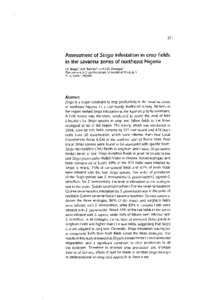| dc.contributor.author | Dugje, I.Y. |
| dc.contributor.author | Kamara, A.Y. |
| dc.contributor.author | Omoigui, L.O. |
| dc.date.accessioned | 2019-12-04T11:14:22Z |
| dc.date.available | 2019-12-04T11:14:22Z |
| dc.date.issued | 2007 |
| dc.identifier.citation | Dugje, I.Y., Kamara, A.Y. & Omoigui, L.O. (2007). Assessment of Striga infestation in crop fields in the savanna zones of northeast Nigeria. In Fifth biennial regional maize workshop: demand-driven technologies for sustainable maize production in West and Central Africa (pp. 271-281), 3-6 May, Cotonou, Benin. |
| dc.identifier.uri | https://hdl.handle.net/20.500.12478/2746 |
| dc.description.abstract | Striga is a major constraint to crop productivity in the savanna zones of northeast Nigeria. In a community livelihood survey, farmers in the region ranked Striga infestation as the topmost priority constraint. A field survey was, therefore, conducted to assess the level of field infestation by Striga species in crop and fallow fields in the three ecological zones of the region. The survey, which was conducted in 2004, covered 935 fields comprising 459 compounds and 476 bush fields from 30 communities, which were selected from four Local Government Areas (LGA) in the southern part of Borno State. Four major Striga species were found to be associated with specific hosts: Striga hermonthica (Del.) Benth in sorghum and maize; Striga aspera (Willd.) Benth in rice; Striga densiflora Benth in pearl millet and fallow and Striga gesnerioides (willd.) Vatke in cowpea. Across ecologies and fields (compound or bush), 68% of the 935 fields were infested by Striga. Similarly, 75% of compound fields and 62% of bush fields were infested with the four Striga species. The order of prevalence of the Striga species was S. hermonthica>S. gesnerioides>S. aspera>S. densiflora. For S. hermonthica, the level of infestation in the ecologies was in the order: Sudan savanna>northern Guinea savanna>southern Guinea savanna while infestation by S. gesnerioides was in the order of northern Guinea savanna>Sudan savanna>southern Guineas savanna. Across the three ecologies, 86% of the maize and sorghum fields were infested with S. hermonthica, while 83% of cowpea fields were infested with S. gesnerioides. About 44% of the rice fields in the zones were infested with S. aspera, while 36% of fallows were infested with S. densiflora. In all ecologies, the number of emerged Striga plants in sorghum fields was higher than in maize fields, suggesting that Striga is more adapted in sorghum. Generally, Striga infestation was higher in compound fields than bush fields across the three ecologies. The results of this study showed that Striga is a major factor in environmental degradation and a significant constraint to crop production in all the ecologies. Therefore to improve crop production and increase income of farmers, efforts should be made to combat Striga through multidimensional or integrated approach in these areas. |
| dc.format.extent | 271-281 |
| dc.language.iso | en |
| dc.publisher | International Institute of Tropical Agriculture |
| dc.subject | Striga Gesnerioides |
| dc.subject | Striga |
| dc.subject | Cowpeas |
| dc.subject | Sorghum |
| dc.subject | Rice |
| dc.subject | Livelihoods |
| dc.subject | Ecological Zones |
| dc.subject | Crop Production |
| dc.title | Assessment of striga infestation in crop fields in the savanna zones of northeast Nigeria |
| dc.type | Conference Paper |
| dc.description.version | Peer Review |
| cg.contributor.affiliation | University of Maiduguri |
| cg.contributor.affiliation | International Institute of Tropical Agriculture |
| cg.coverage.region | Africa |
| cg.coverage.region | West Africa |
| cg.coverage.country | Nigeria |
| cg.authorship.types | CGIAR and developing country institute |
| cg.iitasubject | Cowpea |
| cg.iitasubject | Livelihoods |
| cg.iitasubject | Plant Diseases |
| cg.iitasubject | Plant Health |
| cg.iitasubject | Plant Production |
| cg.howpublished | Formally Published |
| cg.publicationplace | Ibadan, Nigeria |
| cg.accessibilitystatus | Limited Access |
| local.dspaceid | 93750 |
| cg.targetaudience | Scientists |

